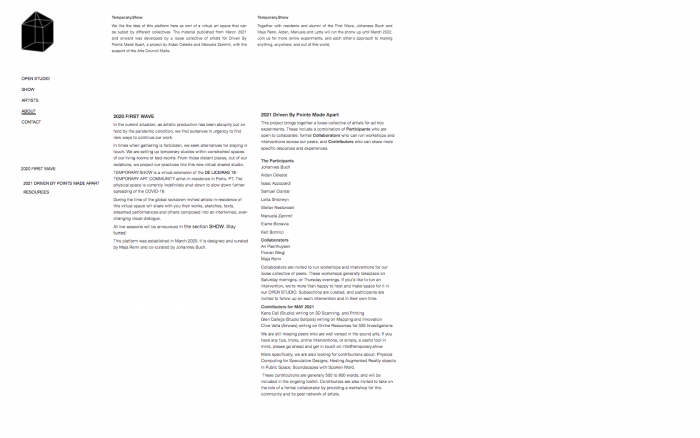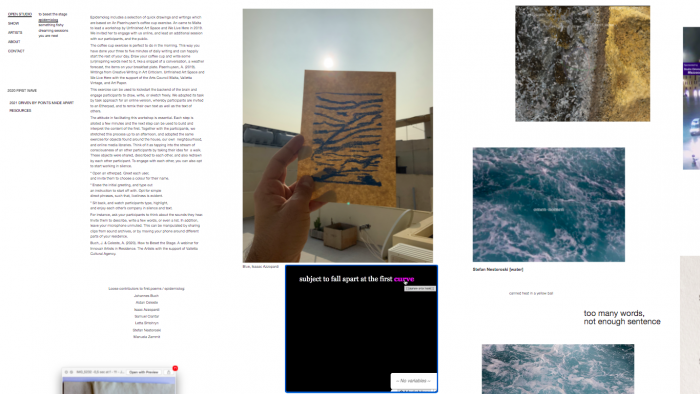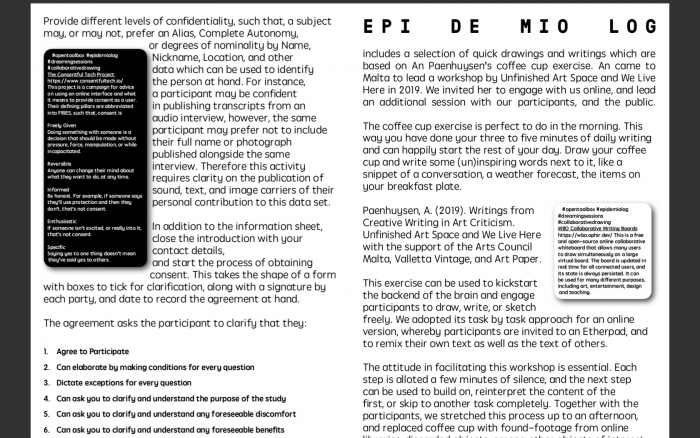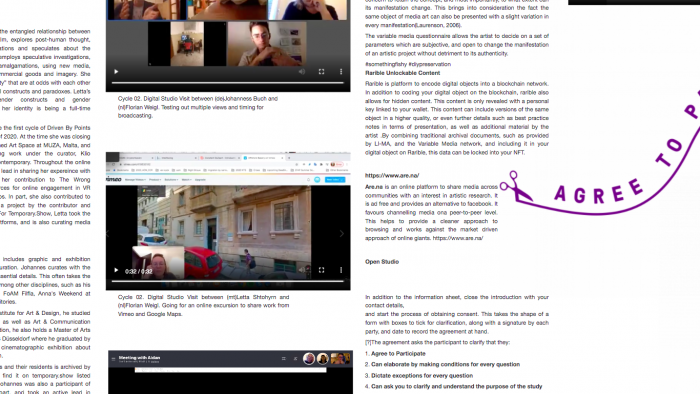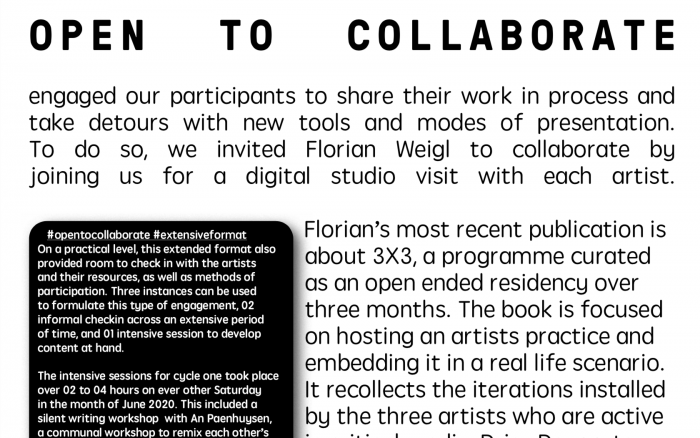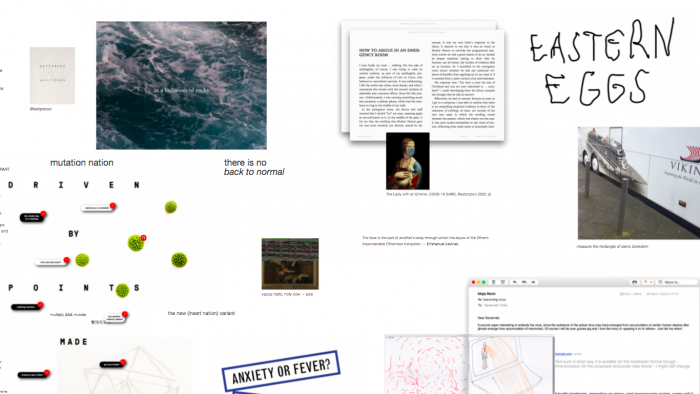I. SUMMARY INFORMATION
Project
269731
Status
Submitted
Award category
Mobilisation of culture, arts and communities
You want to submit
NEW EUROPEAN BAUHAUS AWARDS : existing completed examples
Project title
(mt)Driven By Points Made Apart
Full project title
(mt)Driven By Points Made Apart in collaboration with (pt)De Liceiras 18 for (eu)Temporary.Show
Description
We believe that platform culture has reached a tipping point. Rather than create a whole new space online, we preferred to share one across communities and open our toolbox for other loose collectives.
The original aim of the project was to engage with new media for online collaboration, and provide a departure point for autonomous publishing and peer to peer work across communities. In order to do so we joined De Liceiras 18 and agreed to share what we learnt by adopting Temporary.show
Where was your project implemented in the EU?
Malta
Pan European
Arts Council Malta, TG Complex Suite 1, Level 1, Brewery Street, Mriehel
Birkirkara
BKR 3000
When was your project implemented?
Has your project benefited from EU programmes or funds?
No
Which programme(s) or fund(s)? Provide the name of the programme(s)/fund(s), the strand/action line as relevant and the year.
II. DESCRIPTION OF THE PROJECT
Please provide a summary of your project
(eu)Temporary.Show developed out of residents and alumni for (pt)De Liceiras 18 and (mt)Driven By Points Made Apart. In addition to 2020 First Wave, we engaged participants over 03 cycles for DbyPMA . Each cycle was executed in 03 types of online meetings and a few new artists with every session. The first meeting was always run by peers and used to engage the imagination, the second set was used to engage the expertise of an additional collaborator, and the third engaged new participants to intervene with feedback.
Our approach provides for more of a method than a collective. By focusing on hosting a practical engagement, participants were invited to remix each other’s work and methods. As lead artists, myself, Aidan Celeste, and Manuela Zammit facilitated the process for participants, and identified what specific needs and online resources for this engagement to take shape. Participants took on the lead to assist each other with resources by the second cycle, as well as offer their own expertise amongst one another.
At some point or another in 2020, all the participants were forced to move out of their original practice and peer network. Pascal Gielen (European Culture Foundation) notes that these two aspects are essential to artistic practice. He goes on to include monetisation, and validation within civil society, as part of the same biotope for wellbeing in the arts. Every engagement is now turned on its head, and the basis for a biotope are threatened by measures of social distance. This project does not intend to replace traditional ways to host artistic practice and peer to peer engagement, such as a personal studio, or a gallery and its market, however, it does look into reformatting artistic practice with new media, and crossing paths through different hosts and small communities in a safe and secure manner.
Please give information about the key objectives of your project in terms of sustainability and how these have been met
The original aim of the project was to engage with new media for online collaboration, and provide a departure point for autonomous publishing and peer to peer work across communities. The outcome and output is a good starting point to find out about one's online footprint and take an active step to strengthen its impact as a community. The structure alternates between a list of active organisations, practical examples, tools, along with their variations, and a few words by collaborators who are finding ways to engage with an unknown scenario, and reformat.
The original list of participants we brought together includes artists who are displaced from their peers and studios. To encourage autonomy, we invited each to participate by using alternatives to mainstream platforms. Popular documentaries, such as the Social Dilemma and The Great Hack, are making the use and abuse of online activity by such platforms into a public issue. Prior to such campaigns artists in media art were already quite critical of their hosts. To alter the scales of power and social life, activists and artists have designed alternatives to platforms which are market-driven. This approach stems from the feminist, publishing, and hactivist initiatives and aims to empower small communities by practicing with a greater degree of care and autonomy.
All this content is open to collaboration, and new collectives are invited to host it on a yearly basis. This version started to take shape with an online pad in September to November 2020, and it has now found a host as part of another collective on www.temporary.show until March 2022. Ideally, its content travels between collectives and invites creative exchange, as well as different users to develop its resources in the near future.
This reader takes inspiration from Digital Solidarity Networks, an ongoing discussion which you can join on Freenode Webchat.
Please give information about the key objectives of your project in terms of aesthetics and quality of experience beyond functionality and how these have been met
In order to strengthen our online autonomy, we adopted a set of online tools which depend on both exchange and publication for artistic activity. For instance, to start off with, the participants in this project were invited to use Jitsi for every webconference and Etherpad for collaborative writing.
These two platforms have the key characteristics suggested by communities leading the Digital Solidarity Network, they are both open source and non-extractive. A number of organisations who work in part as activists for data politics are making these tools available from the privacy of their server. Open Source tools and forums allow these platforms to develop with direct feedback between the general user, and the advanced developer. This label refers to code which is available for access and reuse, and under creative commons. In addition, Non Extractive Tools make it difficult for larger companies to scrape personal information en masse. Such that, a list of demographics and qualitative preferences which is written by a community of users and saved on a non extractive tool, such as Etherpad, cannot be harvested for data on Google. This allows a community to retain the wealth of data it withholds online and makes it difficult for companies to use it for unnecessary surveillance, ad campaigns, among other market driven activity.
The only way to access and reuse content on tools which are both non extractive and open source is by gaining direct access through the explicit permission of a user from the same community. Therefore the control and value of its content as data for marketing bots is retained within the explicit permissions of the community and its active members.These tools are available online and for free. In order to engage our participants we adopted these tools for simple workshops and meetings. Collaborators agreed to tease out the possibilities of using Jitsi, Etherpad, among others and opt to help developers refine their code with artists.
Please give information about the key objectives of your project in terms of inclusion and how these have been met
What is essential to Driven By Points Made Apart is to find a way to host, and how to keep making and sharing across fluid a loose collective. As we started to cross paths, tools, and opportunities, this distinct experience brought us together in terms of both, a personal narrative as well as practical needs and resources.
This experience of displacement brought us into the same narrative and it is recollected in a series of lines and drawings entitled, Epidemolog. Along with other tangible outputs of this project, they are now hosted online by the Temporary Show. Epidemolog is still open for contributions, and collective workshops are being held by participants to keep this going over 2021. This output is based on our experience with the curator An Paenhuysen and her expertise in the facilitation of writing and creativity. The second cycle included digital studio visits, and its output is primarily knowledge based. Each participant was invited to join us in a meeting with Florian Weigl, a curator who runs 3x3 at the V2_ Lab for Unstable Media and was engaged for digital studio visits. We invited Florian to share what he learnt from the immediate switch to a live, and online audience.
Together, we discussed how to keep a practice going under the measures of social distance, as well as thematics to look back on from last year. This approach to reformat and finding ways to practice with each other is recollected here. We crossed paths with the platform’s founder, Maya Renn, and have agreed to collaborate by sharing resources, as well as running a few workshops to engage each other's collective after the end of this project with ACM in March 2021, and our new host www.temporary.show.
Please give information on the results/impacts achieved by your project in relation to the category you apply for
Digital Autonomy and Media literacy within the community: The main objective is for autonomous engagement with online media. For instance, the knowledge as well as the online activity by each participant is secured within community run infrastructures, or blockchain networks. Former participants, such as Isaac Azzopardi and Samuel Ciantar took on further responsibilities in cycle 01 and contributed emerging media for visualisations, such as broadcasting, and AI generated images. Letta and Johannes took on further responsibilities in cycle 03 and started looking into new platforms to host our digital objects as Non Fungible Objects. More specific contributions were sought for, and provided by other artists, including Elaine Bonavia from the same lot of applicants who ran a project over Arts Council Malta’s special call for projects under COVID-19.
A Peer Network to support each other’s practice online and off.
Opportunities to collaborate with new formats and communities.
Close Collaboration with 02 pan-european collectives:
(pt)De Leceiras 18 over Temporary.Show as of January 2021,
and open discussions with (nl)Varia for a collaboration in late 2021.
The tangible outcomes will continue to take place, and hopefully, develop new outputs of our new host, Temporary.Show via De Liceiras 18. This online space will be curated by Manuela Zammit, Aidan Celeste and Johannes Buch, Maja Renn, Letta Sthorhyn up until March 2022, and open by to contributions by participants from Driven By Points Made Apart, De Leceiras 18, and any new collective interested in joining us.
Output
Closed/Open Studio Workshops, including curated subsections with new artists up until March 2022.
Resources contextualised and available for access and reuse by other communities
Artist Run Collection based on an Ethereum Blockchain.
Online and Offline Reader for online collaboration.
Please explain the way citizens benefiting from or affected by the project and civil society have been involved in the project and what has been the impact of this involvement on the project
To try minimising the displacement and disruption that has affected many, Manuela Zammit, and Aidan Celeste (myself), responded to Arts Council Malta’s Special COVID-19 Call with a project that is designed to bring together a peer group of visual and contemporary artists, collaborating experts and external mentors through periodic online meetings. Our project, ‘Driven by Points Made Apart’ aims to learn from the current condition of working in isolation at home or in its immediate surroundings, as a situation from which fruitful artistic production is still possible.
The project generally worked under the restrictions of social distance and provided for pan-european collaborations. Every participant except for the applicant was moving across different countries and keeping in touch with this community through online engagement.
The reader includes resources for tools, community run platforms, advice, instructions, and references to inspirational work for online collaboration. The samples are necessary in order to communicate how this process developed on a practical basis, along with any insights and opportunities along the way. For instance, the production notes include references to methodologies, such as intensive and extensive modes of collaboration, and the interventions are aligned with online tools among other resources. Being open to collaboration was essential and participants also went on to determine the content, including secure hosts, such as Rarible, and ADT by Lima, Media libraries, among other resources.
Please highlight the innovative character of the project
The whole experience is be compiled in the form of a toolkit and will be available online. Other groups or collectives are invited to access and reuse it for their own content. It will include practical experiments and resources about autonomous publishing in the physical and virtual domains. In a time when data politics are finally going mainstream, the group will test out open-source frameworks for collaboration and exchange in the visual and contemporary arts.
For instance, Jitsi and Etherpads are used in the first cycle in order to run practical experiments with text-based work, while more playful media is used later on. These platforms are online and very much part of the DIY culture. Their codes are open for access and use, and different versions are made available by community-run initiatives for online media. In such a way, this project encourages artists to consider the worth of online data, as well as alternative ecosystems for exchange and publication.
By the end, we found hospitality in another European collective (De Liceiras 18) and committed ourselves to share and publish resources on their platform(image 02a). The outcome (and follow up) is to keep these resources alive by finding hosts across collectives and their peers to use it. The main criterion for new hosts is to identify collective value autonomy and online communities over market driven platforms
Please explain how the project led to results or learnings which could be transferred to other interested parties
The high number of international participants, and their commitment to contribute as a follow up is a definite outcome of our collaboration with De Liceiras 18 and our project’s original objective: to engage artists who are displaced from their immediate peers due to a pandemic and invite them to collaborate with each other online. In addition, the artist in residence for De Leceiras 18, and their alumni participated in our last cycle from across Europe. Their peers are mainly based in Zurich and Porto, and as such, so was our wider audience in the making. We like the idea of sharing resources across small communities, and this outcome is an essential part of the project’s legacy
Is an evaluation report or any relevant independent evaluation source available?
No
III. UPLOAD PICTURES
IV. VALIDATION
By ticking this box, you declare that all the information provided in this form is factually correct, that the proposed project has not been proposed for the Awards more than once under the same category and that it has not been subject to any type of investigation, which could lead to a financial correction because of irregularities or fraud.
Yes
